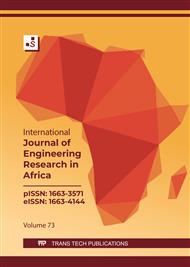[1]
S.J. Chapman, Electric Machinery Fundamentals, 5th ed., McGraw-Hill, Inc., New York, 2012.
Google Scholar
[2]
R. Calik, R.O. Simsek, O.C. Kivanc, A Simple Recursive Least Squares Approach for Off-line Parameter Identification of FOC Permanent Magnet Synchronous Machine Drive, 2022 Global Energy Conference (GEC), 2022, pp.340-344.
DOI: 10.1109/gec55014.2022.9986582
Google Scholar
[3]
S.D. Niño-Callejas, J.C. Palombi-Gómez, O.D. Montoya-Giraldo, Applying the Sine-Cosine Optimization Algorithm to the Parametric Estimation Problem in Three-Phase Induction Motors, Ingeniería e Investigación (2024).
DOI: 10.15446/ing.investig.110310
Google Scholar
[4]
F. Duan, R. Zivanovic, S.F. Al-Sarawi, D. Mba, Induction Motor Parameter Estimation Using Sparse Grid Optimization Algorithm, IEEE Trans. Ind. Informatics Vol. 12, No. 3, pp.1453-1461 (2016).
DOI: 10.1109/tii.2016.2573743
Google Scholar
[5]
H. Ascencion-Mestiza, S. Maximov, E. Mezura-Montes, J.C. Olivares-Galvan, R. Ocon-Valdez, R. Escarela-Perez, Estimation of the Equivalent Circuit Parameters in Transformers Using Evolutionary Algorithms, Mathematical and Computational Applications (2023).
DOI: 10.3390/mca28020036
Google Scholar
[6]
J. Susanto, S. Islam, Improved Parameter Estimation Techniques for Induction Motors using Hybrid Algorithms, arXiv:1704.02424 (2017).
Google Scholar
[7]
G.F.V. Amaral, J.M.R. Baccarini, F.C.R. Coelho, L.M. Rabelo, A High Precision Method for Induction Machine Parameters Estimation From Manufacturer Data, IEEE Trans. Energy Convers. Vol. 36, No. 2, pp.1226-1233 (2021).
DOI: 10.1109/tec.2020.3032320
Google Scholar
[8]
P. Pillay, R. Nollan, T. Haque, Application of Genetic Algorithms to Motor Parameter Determination for Transient Torque Calculations, IEEE Trans. Ind. Appl. Vol. 33, No. 5, pp.1273-1282 (1997).
DOI: 10.1109/28.633806
Google Scholar
[9]
C. Eder, P. Lairez, R. Mohr, M.S. Din, A Signature-Based Algorithm for Computing the Nondegenerate Locus of a Polynomial System, J. Symb. Comput. Vol. 119, pp.1-21 (2022).
DOI: 10.1016/j.jsc.2023.02.001
Google Scholar
[10]
J.L. Awange, B. Palancz, R.H. Lewis, Groebner Basis in Geodesy and Geoinformatics, International Congress on Mathematical Software (2014).
Google Scholar
[11]
Y.J. Liu, J. Peddieson, Application of Groebner Basis Methodology to Nonlinear Mechanics Problems, International Congress on Mathematical Software (2014).
DOI: 10.1007/978-3-662-44199-2_61
Google Scholar
[12]
J. Wu, Y. Zheng, Z. Gao, Y. Jiang, X. Hu, Y. Zhu, J. Jiao, M. Liu, Quadratic Pose Estimation Problems: Globally Optimal Solutions, Solvability/Observability Analysis, and Uncertainty Description, IEEE Trans. Robot. Vol. 38, pp.3314-3335 (2022).
DOI: 10.1109/tro.2022.3155880
Google Scholar
[13]
T. Ito, Y. Hoshi, N. Shinohara, S. Uchiyama, Polynomial Selection of F4 for Solving the MQ Problem, JSIAM Lett. Vol. 14, pp.135-138 (2022).
DOI: 10.14495/jsiaml.14.135
Google Scholar
[14]
M. Díaz-Cortés, E. Cuevas, R. Rojas, Gravitational Search Algorithm Applied to Parameter Identification for Induction Motors, in: Advances in Soft Computing (2017).
DOI: 10.1007/978-3-319-57813-2_3
Google Scholar
[15]
R.-C. Wu, Y.-W. Tseng, C.-Y. Chen, Estimating Parameters of the Induction Machine by the Polynomial Regression, Applied Sciences Vol. 8, No. 7, p.1073 (2018).
DOI: 10.3390/app8071073
Google Scholar
[16]
B. Buchberger, An Algorithm for Finding the Bases Elements of the Residue Class Ring Modulo a Zero Dimensional Polynomial Ideal (German), PhD thesis, Univ. of Innsbruck (Austria), (1965).
DOI: 10.1016/j.jsc.2005.09.007
Google Scholar
[17]
B. Buchberger, An Algorithmic Criterion for the Solvability of Algebraic Systems of Equations (German), Aequationes Mathematicae Vol. 4, No. 3, pp.374-383 (1970).
Google Scholar


